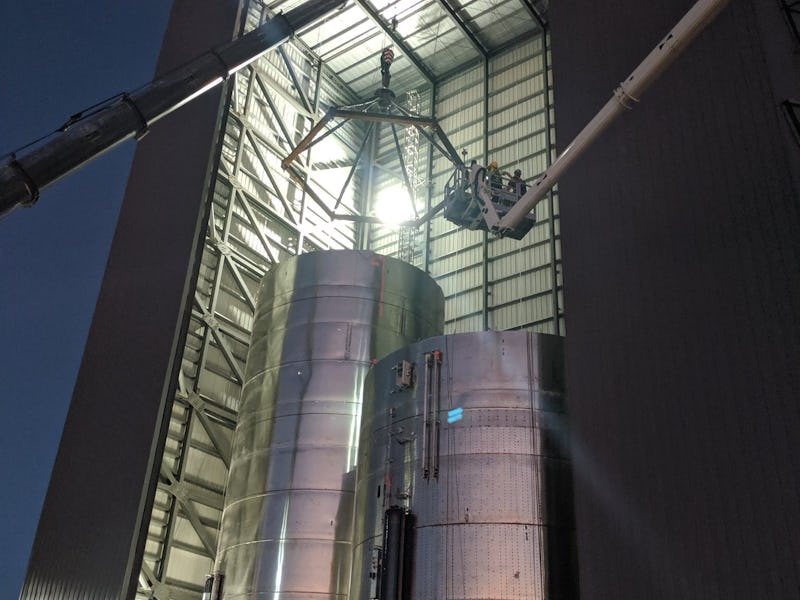SpaceX Starship: Elon Musk’s next prototype could break new ground
The company's space-bound rocket is taking shape.

SpaceX's most eye-catching project has taken a new step toward the future.
On Thursday, CEO Elon Musk shared an image via Twitter of the company's under-construction Starship prototype. The model, dubbed "SN3," is the latest version of the rocket designed to send humans to Mars, set up a city, and travel out further to establish a multi-planetary species. All this is expected to be done using a stainless steel rocket that measures 393 feet including the Super Heavy booster.
The "SN3" prototype is a key milestone on that journey. Musk previously explained on March 9 that this iteration of the ship would be aimed at supporting static test fires and short flights. That would make it the first full-size Starship prototype to fly. Musk also suggested in the same post that its successor, "SN4," could complete even longer flights.
Considering the impressive images that emerged after the August 2019 Starhopper flight, it could lead to a visually stunning display.
SN3 under construction.
It's been a long journey to make it to this stage. SpaceX has been developing the Starship at the Boca Chica facility in Texas. It uses a Raptor engine, which unlike the company's Falcon 9 Merlin engines uses liquid oxygen and methane as fuel. This, combined with the ship's fully-reusable design, means humans can land on Mars and harvest resources to refuel and continue the journey.
Musk detailed this idea at a September 2017 conference, with a ship then dubbed "BFR." Around 12 months later, it emerged the ship had undergone a Tintin-inspired redesign and would now be known as Starship. The Starship Raptor engine first fired on February 4, 2019. Two months later, a miniaturized version of the Starship dubbed "Starhopper" completed a tethered firing. In July 2019 it hopped around 65 feet, and in August 2019 it flew around 500 feet into the air.
The first full-size Starship was unveiled in September 2019, dubbed "Mk.1," at a press conference at the Boca Chica facility. It was expected to complete an orbital flight in October but this never materialized. Instead, the top blew off during a November test.
Starship Mk.1.
Instead, the team conducted a series of pressure tests to improve its manufacturing process. In January, the team's test tank successfully withstood 7.5 bar at room temperature, then 8.5 bar at cryo temperatures. Musk has previously suggested that a ship would need to withstand pressures around these rates to send humans into space.
The design has undergone refinements over this period, increasing the size and improving the ways the team joins the steel rings together. Musk was reportedly left annoyed after a March test failed and "SN1" was destroyed. "SN2," which aimed to fix the issue that caused its predecessor to explode, survived a test later in the month.
While these seem like unexpected setbacks, it's important to note that the Starship has been largely following the expected timeline outlined by Musk in January 2019. At that point, he said that an orbital prototype would be ready in June, and post-Starhopper flights would run in 2020 or possibly sooner.
If SpaceX meets its goals, Starship could fly missions relatively soon. A satellite launch has been suggested for 2021 for a third-party client. The company is also expected to send Japanese billionaire Yusaku Maezawa on a trip around the moon sometime in 2023. A city on Mars is slated for establishment before 2050.
The Inverse analysis
It's an ambitious timescale, but SpaceX could meet a lot of its deadline goals for the Starship. Some of them are perhaps too farfetched, like landing on Mars by 2022, a goal that even Musk described in September 2017 as "aspirational." The big question is whether external forces could slow down its plans.
It's entirely possible that SpaceX's plans are delayed by the ongoing coronavirus pandemic. At least one employee has tested positive for the virus at the company's Hawthorne, California headquarters, CNBC reported Tuesday. The Telegraph also reported that the company sent home 12 employees to go into quarantine.
"SN3" may be on the way, but it wouldn't be too surprising if the company has to rethink its roadmap amid the outbreak.